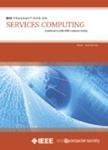版权所有:内蒙古大学图书馆 技术提供:维普资讯• 智图
内蒙古自治区呼和浩特市赛罕区大学西街235号 邮编: 010021

作者机构:South China Univ Technol Sch Comp Sci & Engn Guangzhou 510006 Peoples R China Pengcheng Lab Shenzhen 518055 Peoples R China SUNY Coll New Paltz Dept Comp Sci New Paltz NY 12561 USA
出 版 物:《IEEE TRANSACTIONS ON SERVICES COMPUTING》 (IEEE Trans. Serv. Comput.)
年 卷 期:2025年第18卷第1期
页 面:372-384页
核心收录:
学科分类:0808[工学-电气工程] 08[工学] 0835[工学-软件工程] 0812[工学-计算机科学与技术(可授工学、理学学位)]
基 金:National Natural Science Foundation of China Major Key Project of PCL,China [PCL2023A09] Guangzhou Development Zone Science and Technology Project [2023GH02]
主 题:Runtime Accuracy Fuzzy logic Training Predictive models Servers Robustness Computer science Artificial neural networks Prediction algorithms Deep neuro-fuzzy system edge server heterogeneous device prediction
摘 要:Predicting the runtime of tasks is of great significance as it can help users better understand the future runtime consumption of the tasks and make decisions for their heterogeneous devices, or be applied to task scheduling. Learning features from user task history data for predicting task runtime is a mainstream method. However, this method faces many challenges when applied to edge intelligence. In the Big Data era, user devices and data features are constantly evolving, necessitating frequent model retrains. Meanwhile, the noisy data from these devices requires robust methods for valuable insight extraction. In this paper, we propose an edge server-oriented deep neuro-fuzzy system (ESODNFS) that can be trained and inferred on edge servers, for providing users with task runtime prediction services. We divided the dataset and trained it on multiple improved adaptive-network-based fuzzy inference system units (ANFISU), and finally conducted joint training on a deep neural network (DNN). By partitioning the dataset, we reduced the number of parameters for each ANFISU, and at the same time, multiple units can be trained in parallel, supporting fast training and iteration. Additionally, the application of fuzzy inference can effectively learn the features in noisy data and make accurate predictions. The experimental results show that ESODNFS can accurately predict the runtime of real tasks. Compared with other DNN and DNFS, it can achieve good prediction results while reducing training time by over 35%.